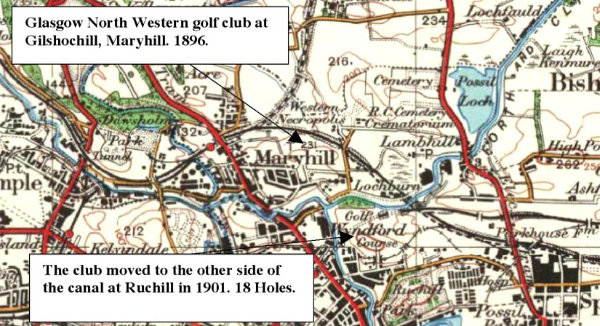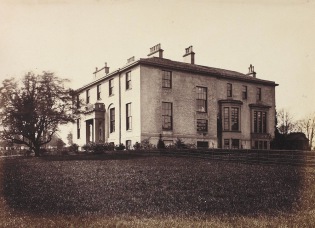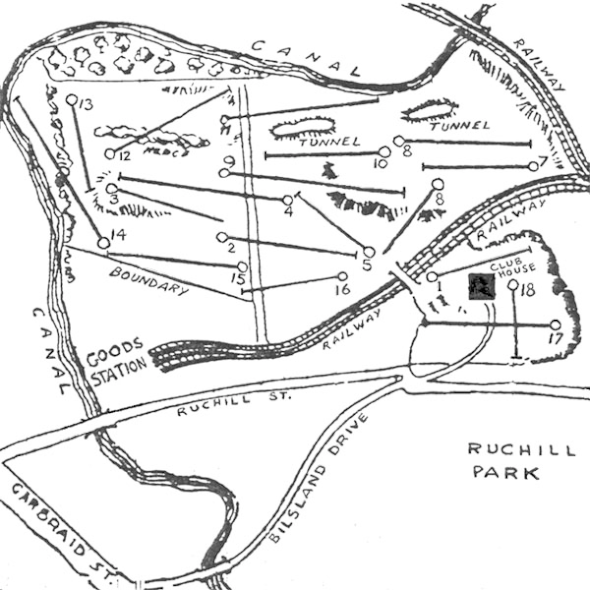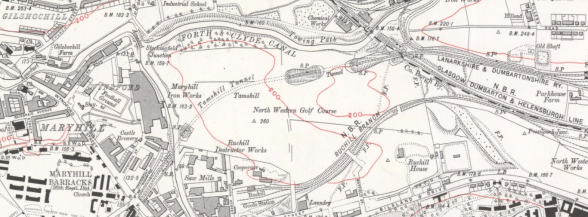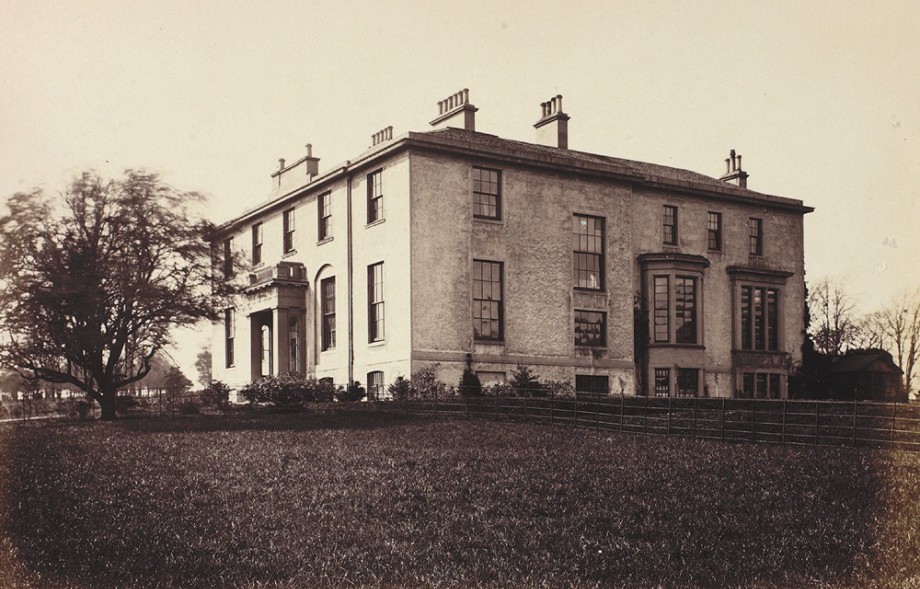
The Luxuirious Mansion House ( Clubhouse )
Ruchill Golf Course
The second home of the Glasgow North Western Golf Club
In 1928 the North Western club was dispossessed of its ground by the Greater Glasgow Housing association for housing development and the members joined with those of Bankhead GC to form Hilton Park GC. The course was taken over by the Corporation , reduced to 9 holes, and remained open till recently ( 2019 ) as Ruchill Park Golf Course.
"At a meeting held in Maryhill last night, it was agreed to form a golf club in Maryhill, to be called " The North Western Golf Club."
The ground consits of 49 acres, suitable for a nine-hole course, and is situated on Gilshochill Estate. One hundred and twenty names have already been enrolled." (EEN 6.11.1895)
Glasgow Evening Times November 19th 1900
Glasgow North Western Club’s New Course
On Saturday afternoon the members of the Glagow North Western golf club formally opened an 18 hole course at Ruchill. The day was all that could be desired, and as a result there was an exceptionally large turnout of both players and spectators. Ballie Cleland, who was presented with a golf club for the purpose, drove off the first ball and declared the course open. Play was thereafter generally indulged in.
Glagow Evening Times November 23rd 1900
Opening At Ruchill
Splendid weather favoured the opening last Saturday of the new course of the Glasgow North Western golf club at Ruchill. Among those who took part in the function were Baillie Cleland, Councillor Carrick Webster, Captain D. Walker, Mr J. McLachlan, and Mr Kininmonth. Many lady members of the club also graced the gathering with their presence. Of notable golfers there were not a few, the more prominent among them being Messrs W.J.G. and C.B. Macfarlane. Notwithstanding the heavy rainfall which has been experienced during the past six or seven weeks, the course was found to be, considering it’s newness, in surprisingly good order. A considerable number of those present engaged in foursomes, but a few played round in singles. The scoring was moderate, with the exception of a very fine performance which was accomplished by Willie Macfarlane. Playing with Mr W. Mollison, Mr Macfarlane got the grip of the greens from the very start, and compiled the grand total of 73. In view of the fact that this was only Mr Macfarlane’s second game over the links, the score represents grand golf. It also confirms my impression that it will be advisable to lengthen a few of the holes at the earliest possible moment. There should be at least three or four 5 – holes in an 18 hole course, else the long driver is severely handicapped.
Glasgow Evening Times May 10th 1902
Ruchill Golf Course
( A Description )
"Nowhere in Britain has the golf boom been so pronounced as in the Glasgow district. A dozen years ago the courses round about the city could have been counted on one hand, now there are a score, within a radius of seven miles from the Royal Exchange. Not the least interesting of these is the eighteen-hole links of the Glasgow North Western Club at Ruchill. Half a century ago Ruchill mansion and grounds were well beyond the limits of the city, but so rapidly has Glasgow developed that its tentacles, have already reached this once charming rural resort. While the immediate surroundings are less sylvan than they were the glorious prospect to the north and south-west is unimpaired From the third hole, which is 300 feet above the level of the sea, a truly magnificent view is obtained of the Campsie and Kilpatrick Hills, and the towering peaks of Ben Venue, Ben More, Ben Lomond, Ben Lui, and other well-known mountains. Looking down the valley of the Clyde the beholder’s eye is arrested by the bold out line of Goatfell and the rugged ridges of the Argyllshire Hills. The Forth and Clyde Canal bounds the course on the north and west, while Ruchill Hospital and Park come between it and the city on the east.
The ground is hilly, but the holes have been so skilfully laid out as to call for the minimum of climbing. Although the soil is heavy, an excellent coating of turf has been cultivated, due to judicious manuring and top-dressing. The putting greens are wonderfully good. While sand has been used freely, the best results have been obtained from carbon refuse. This material is coarser than sea sand, but it is an admirable fertiliser and fills up with the greatest nicety all the little inequalities in the turf. Another noteworthy feature of the Ruchill course is the excellence of the tees. Where the ground is not level, two, and at some places three, driving off places have been made. The committee are firm believers in the principle that there should be no hazard on the tee.,
As modern links go the course is not a long one, the total length being 4,896 yards, but it boasts of several thoroughly sporting holes. There is no scarcity of hazards, the principal ones being walls, hedges, and trees. Straight driving receives its proper reward, while the approacher gets value for all his accurate shots. The first hole is distant 180 yards, the left being guarded by a line of beeches, while the boundary wall on the right is close to the tee. A good drive should enable a three to be recorded. A ditch, wall and several trees must be carried from the next tee, if the hole, 225 yards, is to be taken in a par 4. The ground rises here. and the balls run very little. Two fine swipes and an iron shot should enable the putter to be used at the third hole, which is 487 yards from the tee. There is a sunk roadway and many players top their seconds into it and run up totals of eight and nine, instead of the regulation five. A downhill drive and a pitch give one a look in for a three on the fourth hole, which is 240 yards in length, but a four represents steady golf. The next (143 yards) is a perfect three, if the adjacent trees, which catch a slightly sliced tee shot, are safely negotiated. A good drive is essential at the sixth green, which is occasionally done in three, but a four is quite satisfactory considering the fact that the line to the hole is up hill. A topped tee stroke is badly punished going to the seventh ~ yards), while a sliced ball lands on the railway. Bar mistakes, a four should be recorded here, but the approach must not be too strong as the green is a built-up one. The eighth (~z yards) requires a long drive up an incline, a good brassie stroke and an iron shot, before the green is reached. A five is par play. The ninth is a comfortable four, the distance from the tee being 250 yards, bringing the total for the outward journey to 36.
The homeward holes are shorter, but they frequently cost more than the other nine, owing to the hazardous nature of the ground. As the fairway narrows at the tenth (281 yards) a straight drive is absolutely necessary, a pulled ball going into the tunnel, and a sliced one reaching the canal. A convenient wall penalises a fluffed approach. The slashing driver can take the eleventh hole (359 yards) in four strokes, but a five is not to be despised. On a moderately calm day a perfect drive should give the player a chance of a three at the next the green being 195 yards from the tee. The hazard here is a seven-foot hedge, which catches a weak, stroke. Three terraces form the twelfth green (270 yards ), which slopes away from the golfer and consequently calls for great accuracy with the iron. The least bit too strong and the ball is over the putting ground. The fourteenth (422 yards) is a long-driver’s hole, and it is important to keep the correct line from the tee. If no mistakes are made in the long game, five strokes should fall to be added to the player’s total. From the position of the green the fifteenth hole, although only 314 yards in length, must be considered a hard four. The sixteenth (182 yards) is a blind hole and three represents perfect golf. If the trees are avoided, the seventeenth (253 yards) should be negotiated in a nice four. Then the home green; there is not a finer in the whole of Scotland. It is raised about a yard above the surrounding ground and measures 40 yards by 20. The grass is beautifully fine and close. The bottom of the hole is frequently reached in two, but a three is entirely satisfactory. A 4 inward makes the par 70, but nobody has yet succeeded in recording that total. The professional record is 71, made this season by John McAndrew, the details of whose score are;
Out 3 3 5 3 3 3 5 5 3 — 33 In 4 5 4 4 5 4 4 4 4 — 38 Total 71
The best amateur score is 73, compiled by Mr Hugh F Macneal and Mr A Mitchell. The scratch total is 78.
The Ruchill mansion makes a commodious clubhouse. Although over 200 years old, the house is in excellent preservation. There are three large public rooms and a well-appointed billiard-room, besides extensive locker accommodation, and there are also separate rooms for ladies.”
The house, shown left, was demolished during or shortly after the First World War.
Length of Course, 5163 yards - Bogey 78
Hole No. 1 2 3 4 5 6 7 8 9
Length in yards 182 293 496 242 159 263 367 449 292
Bogey 4 4 6 4 3 4 5 5 4
Hole No. 10 11 12 13 14 15 16 17 18
Length in yards 279 342 211 267 373 414 220 280 114
Bogey 4 5 4 4 5 5 4 4 3
Evening Times June 3rd 1907
Professional Challenge Match
The concluding half of the professional challenge foursome between T. Watt ( Ranfurly ) and J. Johnston ( Hillfoot ) and G. Gordon ( Cathcart Castle ) and J. McAndrew ( Glasgow North Western ) was played over Ruchill course on Saturday. The match was one of seventy two holes, and the first portion was decided at Old Ranfurly three weeks ago, when Gordon and McAndrew finished with a hole lead. Much interest was taken in the final stage on Saturday, and, although rain fell steadily throughout a large number of spectators followed the match. At the end of the first round the match was all even. The acceptors made a good start in the second round by securing the first hole in three to four. Faulty play, however, lost them the second, which Watt and Johnston took in four to five. Greater accuracy on the green enabled Gordon and McAndrew to win the third. At the fourth McAndrew topped his drive, and the hole went to Watt and Johnston in five to six.
Gordon and McAndrew, however, reduced their opponents lead to one by securing the next two holes in four to five each. They had a splendid chance of bringing the match level at the seventh, at which Johnston drove close into the hedge, Watt, however, made a fine recovery and the hole was halved in five. At the eighth Watt failed to get over the hedge with his drive. Johnston made a splendid attempt to get on to the green, but was just short, and the hole went to Gordon and McAndrew in four to five. The match was thus again level. After a half in four at the ninth, a fine pitch by Gordon was the means of his partner and he gaining the hole in three to four, and the younger players were thus again in the lead. They did not hold the advantage long, as Watt and Johnston squared the match at the next hole in five to six. Halves in three and four followed. At the fourteenth, Johnston had a magnificent mashie shot, his ball lying within a foot of the hole, and he and his partner again stood one up. Gordon and McAndrew had an excellent chance of bringing the match level at the next, at which Johnston topped his drive, but they showed faulty play, and the hole went to Watt and Johnston in five to six. Watt and Johnston also secured the sixteenth in five to six, and thus won the match by three up and two to play
Glasgow Herald June 9th 1922
Golfer’s War Memorial
The Glasgow North Western golf club have had a tablet erected in their clubhouse at Ruchill in memory of the 24 members who made the supreme sacrifice in the great war, and the ceremony of unveiling it was successfully performed on Saturday before a large attendance of members and friends by Lady McInnes Shaw, who laid down a beautiful wreath at the conclusion of the ceremony. An appropriate service was held in front of the clubhouse, at which the Captain of the club, Mr Robert Jackson, presided. The officiating clergymen were the Rev. John Anderson, B.D, and the Rev. John Livingston, and the speaker was Sir Archibald McInnes Shaw, an ex Captain of the club. By the courtesy of the commanding officer of the Royal Scots Fusiliers, presently stationed at Maryhill Barracks, the pipe major and a bugler from that regiment played, respectively, a lament and the last post.
Golf Course For Housing Scheme.
Scotsman June 11th 1926
"The Town Council of Glasgow yesterday, by 55 votes to 42, decided to purchase ground on the Ruchill Estate, comprising the North Western Golf Course, for the purpose of a new housing scheme. It is probable that a portion of the ground may be reserved for a public nine-hole golf course."
In 1928 the club was dispossessed of its ground by the Greater Glasgow Housing association for housing development and the members joined with those of Bankhead GC to form Hilton Park GC. The course was taken over by the Corporation , reduced to 9 holes, and opened as Ruchill Municipal golf course which remained opened until recently. ( See Ruchill Municipal for more on this course )
